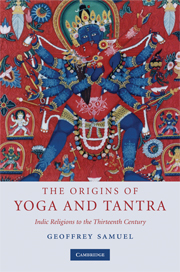Book contents
- Frontmatter
- Contents
- List of figures
- Preface
- 1 Introduction
- 2 Stories and sources
- PART ONE MEDITATION AND YOGA
- PART TWO TANTRA
- 9 The classical synthesis
- 10 Tantra and the wild goddesses
- 11 Subtle bodies, longevity and internal alchemy
- 12 Tantra and the state
- 13 The later history of yoga and Tantra
- 14 Postlude
- References
- Index
9 - The classical synthesis
Published online by Cambridge University Press: 05 June 2012
- Frontmatter
- Contents
- List of figures
- Preface
- 1 Introduction
- 2 Stories and sources
- PART ONE MEDITATION AND YOGA
- PART TWO TANTRA
- 9 The classical synthesis
- 10 Tantra and the wild goddesses
- 11 Subtle bodies, longevity and internal alchemy
- 12 Tantra and the state
- 13 The later history of yoga and Tantra
- 14 Postlude
- References
- Index
Summary
Part Two of the book is focused on the period from the fourth to twelfth centuries CE, essentially from the foundation of the Gupta Empire in around 320 CE to the final establishment of Muslim rule over North and Northeast India. I shall be particularly concerned with the growth of ‘Tantric’ forms of religion. To begin with, some discussion is necessary regarding the years between Part One and Part Two. This is the period in which what might be regarded as the classical synthesis of Indian culture took shape, a synthesis that is most familiar through the great artistic and literary achievements of the Gupta period in North India.
Part One closed with the initial development of what were to become the two alternative and parallel cultural patterns that would shape the history of Indic religions over the centuries to follow. These were the Buddhist/Jain pattern and the Brahmanical pattern. The Buddhist/Jain pattern worked in terms of large monastic religious centres and treated the world of popular and civic religion and of the rituals of everyday life as a parallel sphere that was largely beyond the concern of Buddhist and Jain religious specialists. It appears to have been closely linked to urban centres and the trading and administrative groups within these centres, and initially received a high level of state support.
- Type
- Chapter
- Information
- The Origins of Yoga and TantraIndic Religions to the Thirteenth Century, pp. 193 - 228Publisher: Cambridge University PressPrint publication year: 2008



